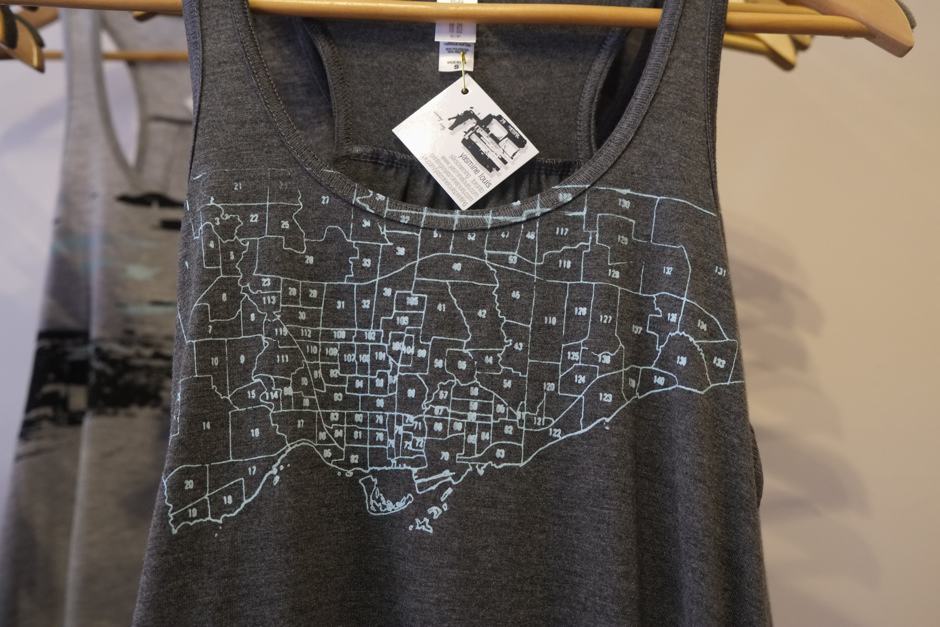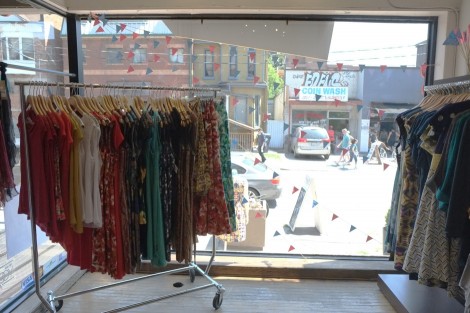Strolling down Queen Street West between Spadina and Bathurst, you may not notice individual textiles amongst the array of colours and patterns wound around spools and piled in bins along the street. However, once it is cut into a few yards and placed in the hands of the city’s local designers, this fabric has the potential to shape the style identity of the city.
Toronto is a geographic puzzle made up of distinct neighbourhoods, each with a unique atmosphere and corresponding identity. Many, Torontonians represent where they live by their clothing choices, acting as a style map of the city; if you become lost, a glimpse at the get-ups around you can help you get a sense of where you are.
Toronto blogger Kaylee Giffin of The Blondielocks observes daily fashion in the city. In her experience, unlike Paris or New York, there is not one style that defines Toronto. “Downtown, you see the different groups of people. Going into the different areas, you see different styles,” she says.
Walking the streets, you’ll spot the hipsters amongst the hippies; and the effortless cool amongst the effortful high-class. Roncesvalles proves that family-friendly does not mean sacrificing style; hip trends often start there before they make their way East through the city. In Parkdale, outfits seem to be often chosen with bike-riding in mind. This is also prominent in Kensington, where vintage, thrifted, handmade, and refurbished clothing is the norm.
Kensington represents a burst of colour and quirk in what Ryerson fashion student Alysia Myette calls a minimalistic style of Toronto. “It’s an interesting kind of style for a city that is so multicultural — with so many people and so many beautiful places. You don’t really find the eccentric until you look for it,” says Myette.
Giffin notes, “Going on the subway, there will be two people that stick out, and everybody else is in just black and don’t have that much of a style.”
A pull in the local fabric
The fashion climate further east past Kensington Market is dominated by mass-market retailers located within the Eaton Centre and along Queen West. The popularity of these mainstream and often more affordable styles has led boutiques that carry unique, local designers and manufacturers to close their doors in the face of soaring rent and fierce competition with big companies. Now, stores that represent Toronto through the clothing and accessories they sell are dwindling.
C (WMCFW) s-s. WMCFW highlights Canadian lines like Mackage, Hilary MacMillan, Pink Tartan, and Beaufille — but while these local designs are hitting the runways, their general lack of affordability for the average shopper stops them short of hitting the streets. For young people on a budget, it can be hard to justify spending so much on Canadian-made designs when there are more practical, budget-friendly alternatives.
Giffin, who has attended Fashion Week, thinks attainability is most attractive to an audience. “One of the models [in the show] was wearing a hat that I had just bought at Target, and I thought, ‘Hey, I own that hat!’” Attainability allows people to re-create outfits that are fashionable with clothing that is available and affordable, and is the inspiration behind Giffin’s blog.
“I think it’s because we are more approachable and reachable than, say, looking at magazines… you look at bloggers and think, ‘These are real people who are actually wearing this stuff out, and I can do this too,’” she says.
Sara Duke, a designer based out of Parkdale, advises, “When trying to find a piece of clothing for a particular lifestyle, the best way to achieve this is to buy something that was designed and made by someone similar to you.”
Myette suggests focusing on Toronto’s Arts & Fashion (FAT) Week as an alternative to WMCFW. “I think World MasterCard Fashion Week is kind of boring. I don’t think I am the only one with that opinion… FAT Week is a lot more eccentric with new and upcoming designers that maybe aren’t as established, whereas I think MasterCard Fashion Week have the same people every year whose style never really changes,” she says.
Fashioning success
Building a fashion business is a challenge, and while large scale fashion week events celebrate the biggest names in style, local designers and their shops struggle to stay afloat. The transition from fashion school to running a line is a struggle made visible by the closing of many small boutiques. However, Laura-Jean Bernhardson, the founder and owner of Toronto-based retailer Fresh Collective, thinks it is possible to be successful.
“My experience with small business people in general is that there is a lack of understanding of what it takes to run a business. [M]ost people go into it with the passion of what they love to do,” says Bernhardson.
Passion is exactly what Duke had after finishing fashion school. “I started my own line because it’s supposed to be fun… I didn’t want to spend my time making very serious pairs of pants for people who had designers,” she says. Duke closed her store in order to focus on her clothing line, which is sold out of local shops such as Coal Miner’s Daughter.
Bernhardson’s Fresh Collective, a store carrying locally designed or manufactured items, provides small business support and coaching catered to designers. Her advice comes from her own experience with starting a business and listening to what customers want.
“We are that local, slow fashion movement, and that is what customers connect with. There is that aware consumer that wants to make a difference with their dollars, and when they wear our clothes, it shows up all over their life. They really brand themselves as that type of person — a thoughtful, socially aware person who is up to something different than the mainstream,” she says.
Myette sees the fashion industry from a different perspective — one of a fashion student that will soon enter a workforce that is not geared towards local designers like herself. “With a small business, you might be the one person who is sourcing, sewing, pattern drafting – who is doing everything — and then still having to make everything on time for fashion weeks and travel… I would rather work at a corporate level of a company because I know I would be paid a decent wage as opposed to the risk of trying to compete with them as a small local business,” she says.
Despite being home to Ryerson’s School of Fashion and large-scale fashion-oriented events, Toronto can be a challenging environment for young, local designers like Myette; with fabric and supply stores dwindling and condos taking over valuable spaces, boutiques are being pushed out of the city.
“Toronto doesn’t value art as much as it does industry. There’s a lot of things that are happening to the city that are making it not the city I thought it would be,” says Myette, adding, “I feel that Toronto may not be the best place currently. It seems to have a lot of focus on fast fashion and mass production, so you’re competing with the very few small businesses that exist here, and it is not a profitable way to go right now for me.”
Bernhardson’s hope, though, is that Toronto’s focus on fast fashion could open up a niche for the slow fashion of local designers — and indeed, some will continue to push on despite the difficulties. “You have to be your own entrepreneur and stand behind what you do,” says Myette.
Fashion inherently expresses one’s personal identity, but also contributes to the identity of the city one lives in. The fabric of Toronto’s fashion identity rests as much in the hands of Toronto consumers as it does in the designers who create wearable, local art.
Berhardson adds, “Part of our philosophy about fashion is that fashion is an art form that we use every day as a means of self-expression. So when a woman is shopping with us, she is buying these unusual dresses and beautiful things and they are in her closet like an art collection, and every day she gets to pull them off [the hangers] and put on a piece of art.”



